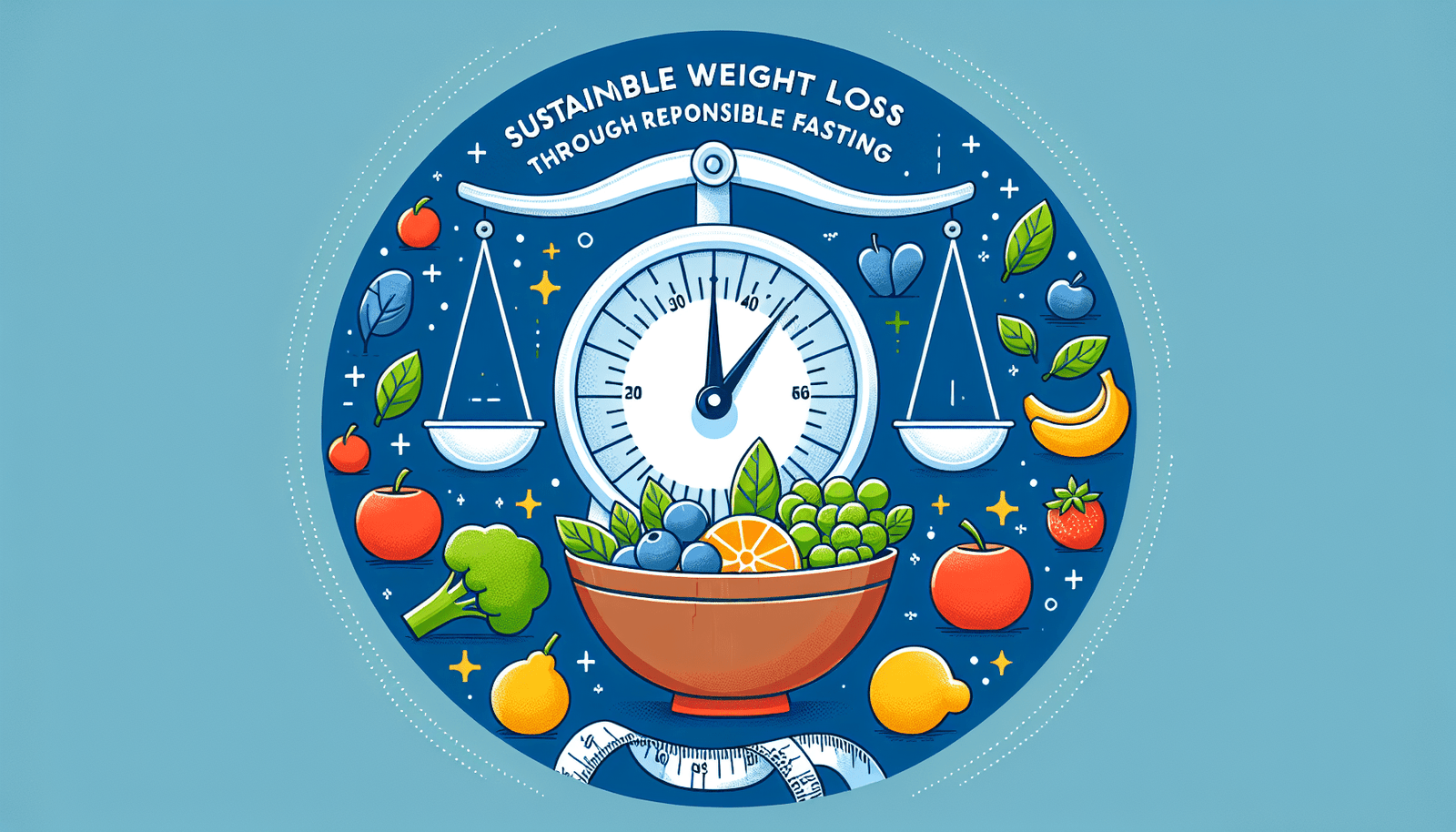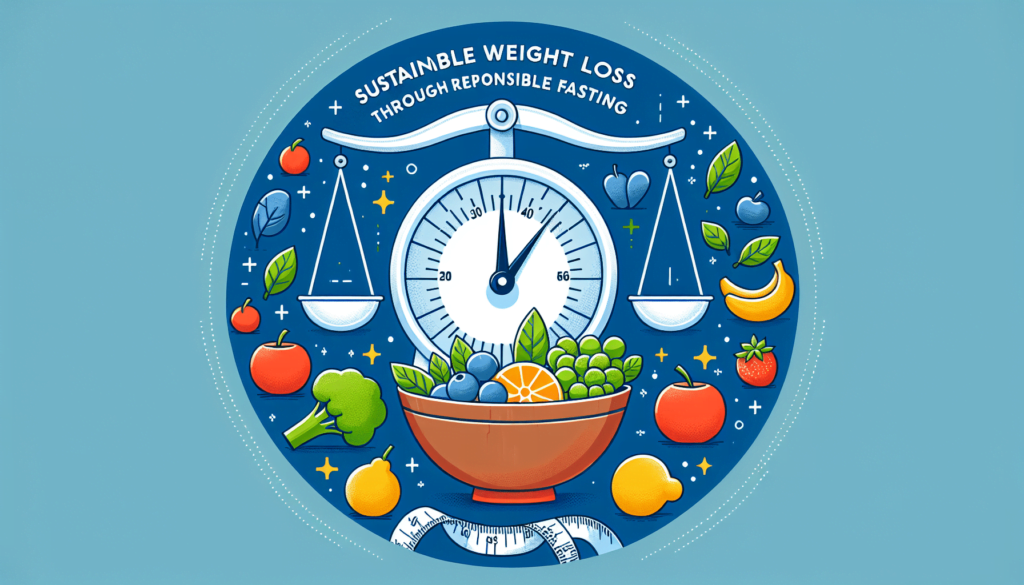So you’ve decided it’s time to shed a few pounds and you’ve heard about the benefits of fasting for weight loss. But where do you start? In this article, we will guide you through the process of safely beginning your fasting journey to help you reach your weight loss goals. By following our tips and advice, you’ll be on your way to a healthier, happier you in no time.

Consult with a healthcare professional
Before starting any fasting regimen, it is crucial to consult with a healthcare professional such as a doctor or registered dietitian. They can provide guidance and support throughout your fasting journey and help tailor your fasting plan to your specific needs and health conditions.
Discuss your plans with a doctor or registered dietitian
By discussing your fasting plans with a healthcare professional, you can ensure that it is safe for you to engage in fasting. They can assess your health history, including any underlying medical conditions, and provide valuable insights into how fasting may impact your overall well-being.
Get a physical check-up
It is a good idea to have a physical check-up before beginning a fasting regimen. This can help determine if there are any underlying health issues that may need to be addressed before embarking on a fasting journey. A physical check-up can also provide a baseline to track your progress as you start fasting for weight loss.
Determine the type of fast suitable for you
There are various fasting methods, and it is essential to determine which one is suitable for your goals, preferences, and lifestyle. Your healthcare professional can help you evaluate the different types of fasting and choose the one that aligns with your needs. Together, you can determine if intermittent fasting, alternate-day fasting, or extended fasting would be the most appropriate option for you.
Educate yourself about fasting
Before diving into fasting for weight loss, it is crucial to educate yourself about the process. Understanding the different types of fasting, the potential benefits and risks, and how it can impact weight loss is essential to embark on this journey safely and confidently.
Learn about the different types of fasting
There are several fasting methods to choose from, each with its own unique approach. Intermittent fasting involves alternating periods of eating and fasting, while alternate-day fasting includes fasting every other day. Extended fasting, on the other hand, involves fasting for longer periods, typically more than 24 hours. By learning about these different methods, you can make an informed decision about which one suits you best.
Understand the potential benefits and risks
Fasting for weight loss can have potential benefits such as improved insulin sensitivity, enhanced fat burning, and weight loss. However, it is essential to understand the potential risks associated with fasting. These may include nutrient deficiencies, muscle loss, and adverse effects on certain medical conditions. By being aware of both the benefits and risks, you can make an informed decision about whether fasting is the right approach for you.
Research the impact on weight loss
While fasting can be an effective weight loss strategy, it is important to understand how it impacts weight loss. Research the science behind fasting, including how it affects your metabolism and fat-burning capabilities. This knowledge will help you set realistic expectations and help you determine if fasting aligns with your weight loss goals.
Set realistic goals
Setting realistic goals is crucial when starting a fasting regimen for weight loss. By defining your weight loss goals, considering the timeline for achieving them, and planning for gradual and sustainable weight loss, you can set yourself up for success.
Define your weight loss goals
To start, consider what you want to achieve with fasting for weight loss. Set specific, measurable, achievable, relevant, and time-bound (SMART) goals. For example, you might aim to lose a certain number of pounds within a particular timeframe. By defining your goals, you can stay motivated and track your progress along the way.
Consider the timeline for achieving your goals
Understanding the timeline for achieving your weight loss goals is important to avoid disappointment or frustration. Recognize that healthy, sustainable weight loss occurs gradually. Discuss with your healthcare professional what a realistic timeline looks like based on your current weight, health status, and chosen fasting method. By having a realistic timeframe in mind, you can stay motivated and patient throughout your fasting journey.
Plan for gradual and sustainable weight loss
Remember that sustainable weight loss is about making long-term, healthy lifestyle changes. Fasting can be a helpful tool in your weight loss journey, but it should be combined with balanced eating, regular physical activity, and stress reduction techniques. Plan for gradual weight loss, aiming to lose 1-2 pounds per week, which is considered a healthy and sustainable rate. This approach will also help you maintain your weight loss in the long run.

Choose the right fasting method
Choosing the right fasting method is crucial for your success and adherence to the fasting regimen. Consider the different fasting methods, such as intermittent fasting, alternate-day fasting, and extended fasting, to find the one that suits your lifestyle and preferences.
Consider intermittent fasting
Intermittent fasting is a popular fasting method that involves cycling between periods of fasting and eating. Common approaches include the 16/8 method, where you fast for 16 hours and have an 8-hour eating window, or the 5:2 method, where you eat normally for five days and limit calorie intake to 500-600 calories on two non-consecutive days. Intermittent fasting allows for flexibility in meal timing and can be easier to incorporate into daily life.
Explore alternate-day fasting
Alternate-day fasting involves fasting every other day or severely restricting calorie intake on fasting days. This approach may be more challenging for some individuals due to the prolonged fasting periods, but it can be effective for weight loss. When considering alternate-day fasting, it is important to listen to your body and make modifications if necessary.
Examine extended fasting options
Extended fasting involves longer periods of fasting, typically more than 24 hours. While it may seem more challenging, extended fasting can yield significant benefits for weight loss. However, this method may not be suitable for everyone. Consult with a healthcare professional before attempting extended fasting to ensure it aligns with your health goals and medical conditions.
Create a fasting schedule
Designing a fasting schedule is essential for maintaining consistency and making fasting a sustainable part of your lifestyle. By designating fasting and eating periods, considering variations to suit your lifestyle, and starting with shorter fasting periods, you can create a fasting schedule that works for you.
Designate fasting and eating periods
Establishing clear fasting and eating periods will help you stay accountable and avoid mindless eating. Determine the duration of your fasting periods, whether it’s the popular 16/8 method or any other fasting window that suits your lifestyle. By designating specific times for fasting and eating, you can develop a routine that supports your weight loss goals.
Consider variations to suit your lifestyle
Fasting schedules should be adaptable to your lifestyle. Consider factors such as work schedule, social engagements, and personal preferences when designing your fasting schedule. You have the flexibility to choose the days and times that work best for you. If traditional fasting schedules do not align with your lifestyle, consult with a healthcare professional to explore modified fasting options that suit your needs.
Start with shorter fasting periods
If you are new to fasting, it is advisable to start with shorter fasting periods and gradually increase the duration over time. This can help your body adapt to fasting and minimize potential side effects. Begin with a fasting window of 12-14 hours and gradually extend it as you become comfortable. Starting slowly allows your body to adjust to the fasting routine, making it easier to stick with long-term.
Stay hydrated
During fasting periods, it is important to stay hydrated to support your overall well-being. By drinking sufficient water during non-fasting periods, considering flavored water or herbal tea, and avoiding excessive caffeine and sugary drinks, you can maintain proper hydration throughout your fasting journey.
Drink sufficient water during non-fasting periods
Hydration is essential for overall health, and it becomes even more important during fasting periods. When you’re not fasting, drink an adequate amount of water throughout the day. Aim for at least 8 cups (64 ounces) of water, or more if you engage in physical activity or live in a hot climate. Staying hydrated can help you feel more energized and reduce the risk of dehydration during fasting.
Consider flavored water or herbal tea
If plain water becomes monotonous, consider adding flavor by infusing it with fruits or herbs. This can make hydration more enjoyable and keep you motivated to drink enough water. Herbal teas, like chamomile or peppermint, can also be a hydrating and soothing option during fasting periods. However, be mindful of calorie content if you’re engaging in a calorie-restricted fasting method.
Avoid excessive caffeine and sugary drinks
While caffeine can be consumed during fasting, excessive amounts may interfere with the fasting benefits. Limit your caffeine intake to moderate levels and choose beverages without added sugars. Avoid sugary drinks, including fruit juices and sodas, as they can disrupt your fasting goals and hinder weight loss progress. Opt for unsweetened beverages or natural flavors to stay on track.
Eat a balanced diet
Although fasting may involve periods of restricted food intake, it is important to prioritize the quality of your meals during eating windows. By consuming nutrient-dense foods, including a variety of fruits and vegetables, and ensuring adequate protein intake, you can support your health and enhance weight loss efforts.
Consume nutrient-dense foods during eating windows
Make the most of your eating windows by choosing nutrient-dense foods. These are foods that are rich in essential vitamins, minerals, and other beneficial compounds. Include whole grains, lean proteins, healthy fats, and plenty of fruits and vegetables in your meals. Prioritizing nutrient-dense foods can help meet your nutritional needs and keep you satisfied during fasting periods.
Include a variety of fruits and vegetables
Fruits and vegetables are an excellent source of vitamins, minerals, and dietary fiber. Aim to include a variety of colors in your meals to ensure you’re getting a wide range of nutrients. Incorporate leafy greens, berries, cruciferous vegetables, and other seasonal produce. Including fruits and vegetables can enhance the nutritional value of your meals and support your weight loss goals.
Ensure adequate protein intake
Protein is an essential nutrient for weight loss and overall health. During eating windows, prioritize protein-rich foods such as lean meats, poultry, fish, eggs, dairy products, legumes, and tofu. Protein can help keep you feeling full and satisfied, support muscle growth, and enhance metabolism. Aim for a protein source in each meal to meet your daily recommended intake.
Monitor your calorie intake
While fasting can be an effective weight loss strategy, it is important to be mindful of your calorie consumption during eating windows. By paying attention to portion sizes, keeping track of your daily calorie intake, and considering the use of a food diary or mobile app, you can stay aware of your energy balance and support your weight loss goals.
Be mindful of portion sizes
Even during eating windows, it is important to be mindful of portion sizes to avoid overeating. Use visual cues, such as the size of your palm or a deck of cards, to estimate appropriate portions of protein, carbohydrates, and fats. Listen to your body’s hunger and fullness cues to guide your portions and avoid mindless eating.
Keep track of your daily calorie consumption
Tracking your daily calorie intake can provide valuable insights into your eating habits and help you stay accountable to your weight loss goals. Consider using a food diary or a mobile app to log your meals and snacks. This way, you can understand how many calories you consume and whether you’re meeting your calorie targets. Tracking can also help identify areas for improvement and make necessary adjustments to your diet.
Consider using a food diary or mobile app
In addition to tracking calories, using a food diary or mobile app can help you monitor other aspects of your diet, such as macronutrient composition. Many apps also offer features to set goals, provide meal suggestions, and track progress. Find a method that works for you and supports your journey towards weight loss and a healthier lifestyle.
Listen to your body
Listening to your body is essential when practicing fasting for weight loss. Pay attention to hunger and satiety cues, prioritize sleep and rest, and be willing to take breaks or modify your fasting plans if necessary. Your body will guide you in finding the right balance and ensuring a sustainable fasting routine.
Pay attention to hunger and satiety cues
During fasting and eating periods, it is important to tune in to your body’s hunger and satiety cues. Eat when you’re genuinely hungry and stop eating when you’re comfortably satiated. Mindful eating can help you develop a healthier relationship with food, prevent overeating, and honor your body’s natural signals.
Rest and prioritize sleep
Sufficient rest and quality sleep are essential for overall health and weight management. While fasting, ensure you prioritize sleep and give your body enough time to rest and recover. Aim for 7-9 hours of sleep per night and establish a sleep routine that supports your well-being. Restorative sleep can enhance your energy levels, regulate hunger hormones, and optimize weight loss efforts.
Take breaks or modify fasting plans if necessary
It is important to remember that fasting is not a one-size-fits-all approach. If you experience any adverse effects or find it challenging to adhere to your fasting plan, be willing to take breaks or modify your approach. Your well-being and overall health should always be your priority. Consult with your healthcare professional if you encounter difficulties adjusting to the fasting routine or if you have concerns about your fasting schedule.
Maintain a balanced lifestyle
To optimize the benefits of fasting for weight loss, it is important to maintain a balanced lifestyle. Incorporate regular physical activity, focus on stress reduction techniques, and ensure sufficient sleep and rest to support your overall well-being.
Incorporate regular physical activity
Physical activity plays a crucial role in weight loss and overall health. To complement your fasting regimen, incorporate regular exercise into your routine. Engage in activities that you enjoy, such as brisk walking, cycling, strength training, or yoga. Aim for at least 150 minutes of moderate-intensity aerobic exercise per week and include strength training exercises at least twice a week.
Focus on stress reduction techniques
Stress can impact weight loss efforts and overall well-being. Incorporate stress reduction techniques such as mindfulness meditation, deep breathing exercises, or gentle yoga. Find activities that help you relax and unwind, and make time for self-care. By reducing stress levels, you can support your weight loss journey and improve your overall health.
Ensure sufficient sleep and rest
Adequate sleep and rest are essential for optimal health and weight management. Make sleep a priority and establish a relaxing bedtime routine. Avoid electronic screens before bed, create a dark and quiet sleep environment, and follow a consistent sleep schedule. By ensuring sufficient sleep and rest, you can support your body’s natural healing processes and optimize the benefits of fasting for weight loss.
In conclusion, starting fasting for weight loss can be a safe and effective strategy when approached with care and consideration. By consulting with a healthcare professional, educating yourself about fasting, setting realistic goals, choosing the right fasting method, creating a fasting schedule, staying hydrated, eating a balanced diet, monitoring your calorie intake, listening to your body, and maintaining a balanced lifestyle, you can embark on a fasting journey that aligns with your goals, promotes sustainable weight loss, and supports your overall well-being. Remember to always prioritize your health, listen to your body, and make adjustments as needed throughout your fasting journey.







